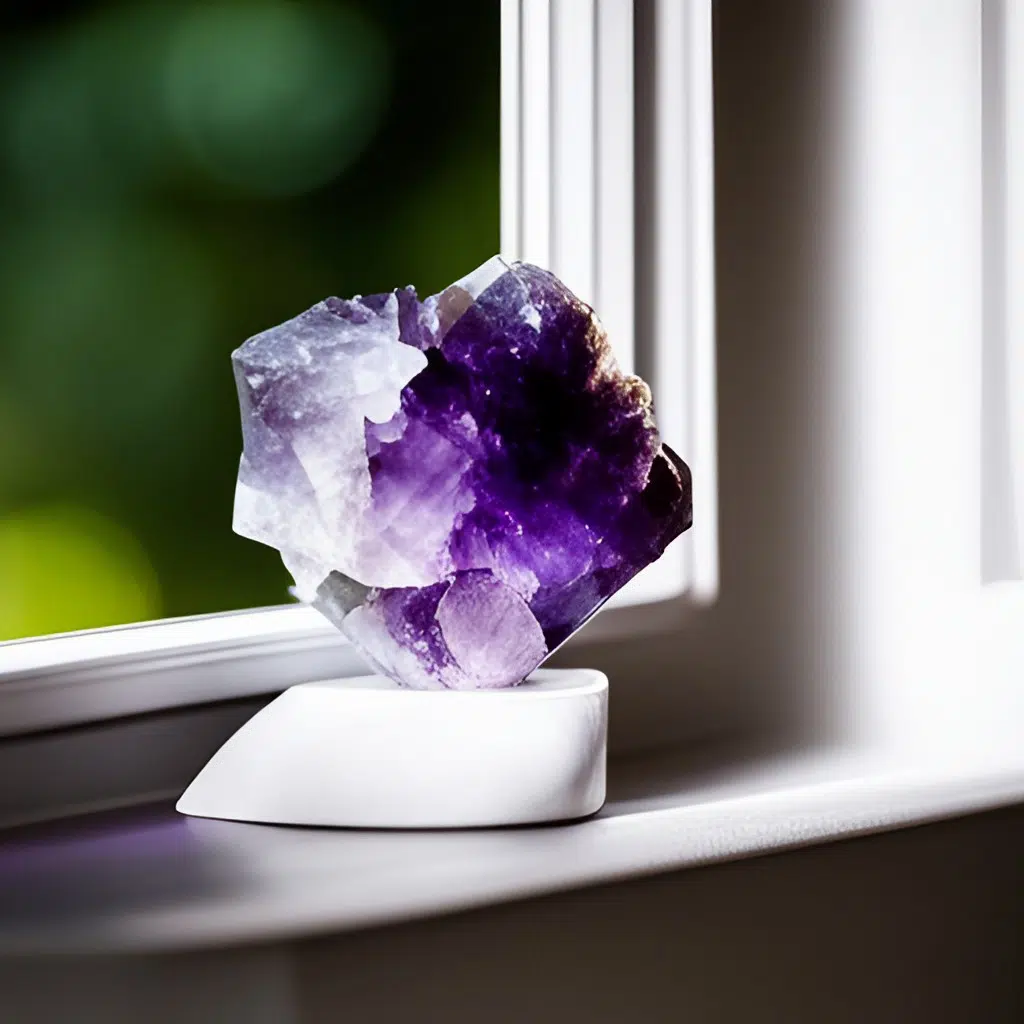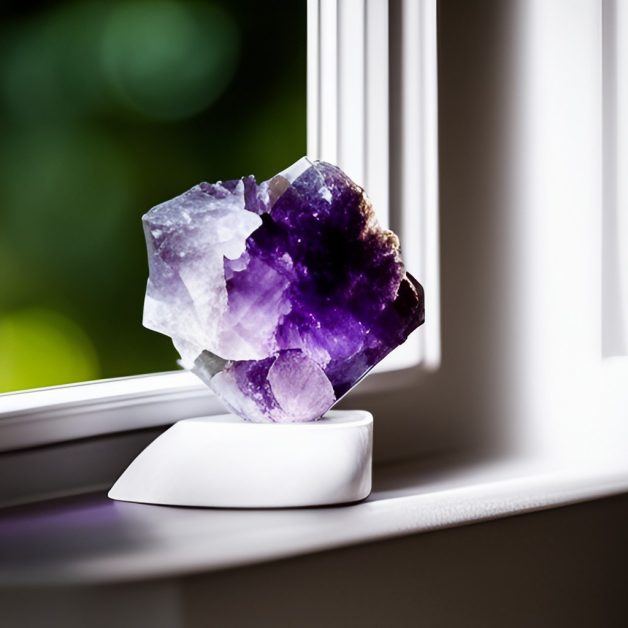Crystals, with their captivating aesthetics and purported metaphysical properties, are much loved by a wide variety of people. Of these glittering gemstones, amethyst — with its deep purple hue — is undoubtedly a standout. But, like any other stone, it has certain characteristics that are worth knowing, especially if you’re a collector or user of this gemstone. One frequently asked question is, “Does amethyst fade in the sun?” Let’s delve into this matter and separate fact from fiction.
Table of Contents
- Understanding the Properties of Amethyst
- Amethyst and Sunlight Exposure: The Science
- Will Putting an Amethyst on My Windowsill Cause It to Fade?
- How to Protect Your Amethyst From Fading
- Conclusion: Does amethyst fade in the sun?
Understanding the Properties of Amethyst
To understand whether or not amethyst fades in the sun, it’s necessary to first take a brief look at the properties of this beautiful stone.

Composition:
First and foremost, let’s talk about its composition. Amethyst is a variety of quartz, and although quartz is a type of mineral that’s commonly found in the earth’s crust, amethyst is recognized for its vibrant purple color which is primarily due to the iron impurities and natural irradiation. Depending on its concentration, this can determine the depth of the hue.
Color Range:
One thing to note is the range of colors that amethyst exhibits. It can range from a subtle pinkish violet to an intense deep purple. Sometimes, it may also showcase one or both secondary hues of blue and red, giving it a unique character. The combination of these colors makes for a stunning and timeless piece of jewelry.
Mohs Hardness:
In terms of hardness, amethyst is a fairly durable gemstone with a Mohs hardness rating of 7. This rating means that it is resistant to scratching, making it ideal for everyday wear. This feature is one of the reasons why many people choose amethyst for not just their jewelry, but also for their home decor, and spiritual healing properties.
Also read: Can amethyst go in water?
Sensitivity:
However, it’s important to know that like many other gemstones, amethyst can be sensitive to certain environmental factors. Of these, heat and sunlight are two factors that you should avoid to preserve the quality of your amethyst piece. This is especially true when it comes to faceted amethyst, as the facets can be damaged or discolored by too much exposure to sunlight or high heat.
Also read: What does amethyst do?
Amethyst and Sunlight Exposure: The Science
The big question is: Does sunlight affect amethyst? The short answer is yes – one of the biggest threats to your beloved amethyst is sunlight exposure. Here’s the more detailed explanation:
Effects of Sunlight:
Amethyst is formed due to the presence of iron impurities within quartz crystals. It’s the iron that gives the crystal its signature purple color. But, when the stone is exposed to sunlight, the UV radiation present can alter the iron’s oxidation state, thus changing the color of the stone.
Also read: Can amethyst go in the sun?
Extent of Color Change:
The extent of color change depends on how long and how intense the stone is exposed to sunlight. Usually, a few hours of direct sunlight might not result in a noticeable difference, but cumulative exposure can cause significant fading. Therefore, it’s essential to keep your amethyst jewelry and crystals away from direct sunlight as much as possible.
Influence of Heat:
The heat associated with sunlight can also contribute to color fading. Amethyst, like many colored gemstones, can be heat sensitive. High temperatures can alter the structure of the stone, leading to color changes.
When amethyst is exposed to heat, the iron impurities inside the stone can undergo oxidation, leading to a loss of color. Therefore, it’s not just sunlight that you need to be wary of, but also exposure to excessive heat, such as leaving your amethyst in a hot car or near a heat source.
Will Putting an Amethyst on My Windowsill Cause It to Fade?
This is a common query among crystal enthusiasts who enjoy displaying their stones in light-catching ways.
Sunlight Exposure:
A windowsill often receives direct sunlight, especially at certain times of the day. As mentioned earlier, prolonged exposure to sunlight and its associated heat can cause amethyst to fade.
Duration of Exposure:
If you’re placing your amethyst on the windowsill just for a few hours, the change might not be noticeable. However, if you make it a permanent spot for your stone, the cumulative exposure to sunlight over weeks and months can definitely lead to fading.
Windows and UV Rays:
It’s also worth noting that while some window glass types can block a portion of UV rays, they don’t necessarily block all. So, even behind a window, your amethyst could still be subject to the fading effects of UV radiation.
Read also: Does citrine fade in the sun?
How to Protect Your Amethyst From Fading
If you love your amethyst and want to preserve its color, here are some tips to keep in mind:
Avoid Direct Sunlight:
As a rule of thumb, keep your amethyst out of direct sunlight. Strong sunlight can cause the color of your crystal to fade over time, which can be a significant disappointment. Instead, look for a spot in your home where your amethyst can be enjoyed without being exposed to direct sunlight. This could be a shaded tabletop or a shelf away from the window.
Regulate Temperature:
In addition to avoiding sunlight, it’s also important to regulate the temperature around your amethyst. High temperatures can cause damage, so avoid placing your crystal near heat sources such as radiators or sunny windowsills. Instead, keep it in a cool, shaded spot where the temperature remains stable.
Safe Storage:
When you’re not using your amethyst, be sure to store it in a safe place. A velvet-lined jewelry box can be a good choice, as it provides a gentle environment that protects the crystal from scratches and other damage. It’s also important to keep your amethyst in a dark place when not in use, as light exposure can cause it to lose its color and luster over time.
Consider a UV-protective Display Case:
If you want to display your amethyst in a more prominent way, you can consider investing in a UV-protective display case. These cases are specifically designed to shield your crystal from the damaging effects of sunlight, while still allowing you to enjoy its beauty. Furthermore, these cases can provide an extra layer of protection against dust, scratches, and other potential hazards.
Conclusion: Does amethyst fade in the sun?
In conclusion, while the regal amethyst is a resilient gemstone, it does indeed fade with prolonged exposure to the sun. Its iron-based purple coloring is sensitive to UV radiation, and heat can also lead to structural changes in the crystal that can affect its color. So, it’s best to play safe and keep your amethysts out of direct sunlight to enjoy their vibrant colors for years to come.
Remember, every crystal has its quirks and idiosyncrasies, just like us. Understanding these characteristics can only enhance our appreciation of these remarkable gifts from the Earth. Enjoy your amethyst responsibly, and its beauty and energy will continue to bring you joy.
